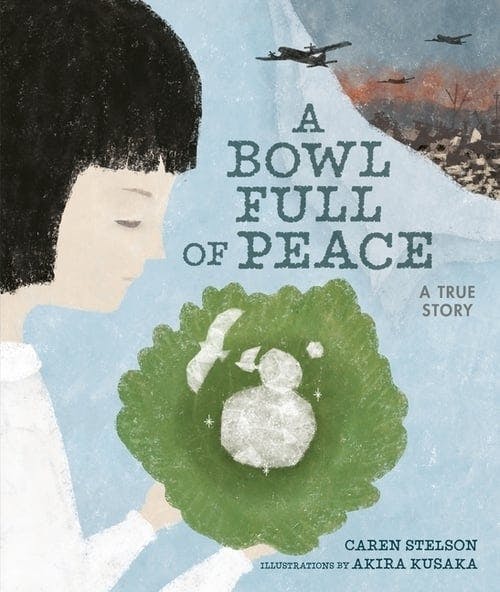

A Bowl Full of Peace
What Does Bookroo Think of This Book
This harrowing tale shares the true story of Sachiko Yasui, whose entire family was killed by the blast or aftermath of the atomic bomb dropped on Nagasaki, Japan. The story centers on a family heirloom, an ornamented green bowl. As the story begins, Sachiko’s family is gathered around the bowl, which is filled with “good things to eat.” As the family feels the impact of a crescendoing world war, the food available for the bowl is reduced until it is only “wheat balls floating in boiled water.” Yet every time before the family eats, they repeat together, “Itadakimasu,” (“We humbly receive this food”). When the atomic bomb is dropped on their city, her baby brother is killed by the blast, followed by her two older brothers, her older sister, her father, and her mother, who all die from radiation. Remarkably, the green bowl survives the bomb blast, and every August, Sachiko places ice—the only thing that could soothe her family’s radiation-burned throats—in the bowl in remembrance of family, loss, and hope of enduring peace. Kusaka’s illustrations have a stark, unembellished aspect, heightening the harshness of the haunting story they movingly portray. Stelson, who learned the story from personally meeting with Sachiko over many years, strikes a balance between conveying and condemning the destruction and loss experienced while giving full weight to the inspiring message of hope and resilience that helped Sachiko endure with an attitude reflected in the declaration, “Itadakimasu.”
What Kind of Book is A Bowl Full of Peace
Primarily about
Topics
Locations
Race, Ethnicities, & Nationalities
Where Does This Book Stand Out
- History
The “History” badge is awarded to recognize books that exceptionally share history.
What Should I Know As a Parent
Families are unique and have different expectations for the books they choose to read. The following are concepts included in this book that some parents may wish to seek out or avoid.
Note that this list is not exhaustive and there may be concepts in this book that are not included or have been insufficiently or incorrectly detailed here.
Reviews
This is an incredibly touching story of family, war, destruction, loss, resilience, hope, and peace. Skillfully written and beautifully illustrated.
A beautiful, educative retelling of a true story, but the story is a sad one full of loss. It's a powerful read in terms of telling a real, devastating story from the effects of war, but it ended feeling more sad than hopeful to me. I think it's an important read, but for older readers as (**SPOILER**) her entire family dies as a result of the radiation from bombs in the war. I honestly didn't care too much that the bowl (symbolizing hope and peace) survived when her family didn't. Not a title I would want to read often.
Book Lists That Include This Book
The Creatives Behind the Book
What Has Caren Stelson Said About This Book
Nothing yet! Let Caren Stelson know that you want to hear from them about their book.
What Has Akira Kusaka Said About This Book
Nothing yet! Let Akira Kusaka know that you want to hear from them about their book.
Similar Books to This Book
Book Details
- ISBN
- 9781541521483
- Publication Date
- August 4, 2020
- Publisher
- Carolrhoda Books
- Original Publication Date
- May 5, 2020
- Page Count
- 40
- Word Count
- 933
- Audience
- Picture
- Reading Age
- 6 - 11 years
- Lib. of Congress (LCCN)
- 2019011878
- WorldCat Number (OCLC)
- 1152296007
- Lexile® Level
- 650L
- Est. Fountas & Pinnell Level
- ~P
- Est. ATOS® Book Level
- ~4.2
Contribute to this page
More than halfway there—keep going!
Just the barebones.
Are you the author or illustrator? Claim your book.


























